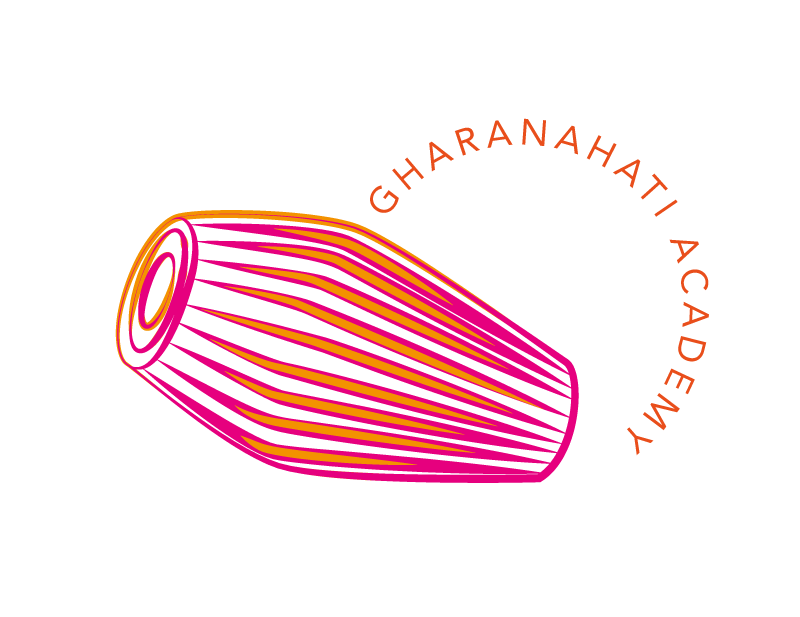Mṛdaṅga Praṇāma
Before picking up the Mṛdaṅga to play, one should always offer obeisances while reciting one of these beautiful praṇāma mantras from Nāradīya Candradayana Candrikā.
namo jagannāthāya-sutāya namo mṛdaṅgāya namaḥ
lāvaṇya-rasa-mādhurī-sahasra-guṇa-samyuktam
namo mṛdaṅgāya namo namaḥ, namo baladevāya namo namaḥ
I offer my respectful obeisances unto the son of Jagannātha Miśra (Lord Caitanya Mahāprabhu). I offer my obeisances to the Mṛdaṅga from which sweet and nectarean sound emanates. I offer my obeisances again and again to the Mṛdaṅga which has thousands of good qualities. Finally, I offer my obeisances unto Lord Baladeva who assumes the form of a Mṛdaṅga to serve Lord Caitanya Mahāprabhu.
mṛdaṅgā-brahma-rūpāya lāvaṇya-rasa-mādhurī
sahasra-guṇa-samyuktam mṛdaṅgāya namo namaḥ
“I bow down again and again to the Mṛdaṅga. It is supreme Brahman transformed into a clay drum that is infused with the sweet mellows of graceful enchantment and endowed with thousands of transcendental qualities.”
Hare Kṛṣṇa Hare Kṛṣṇa Kṛṣṇa Kṛṣṇa Hare Hare
Hare Rāma Hare Rāma Rāma Rāma Hare Hare
Mṛdaṅga Introduction
Bablu Dāsa Mahāśaya gives a basic introduction of the Mṛdaṅga.
Hasta Sādhana
Hand Practice
Hasta means “hand” and sādhana means “the method which makes perfect.” These hand practices are the foundation of mṛdaṅga and are essential for learning. They enable you to master the different techniques and mantras, and they help you to understand the basic rhythms. Practicing hasta-sādhana is like learning the letters of the alphabet.
Mantra:
Tere khetā
Tere khetā is the bīja-mantra of the mṛdaṅga. Bīja means “seed;” all other mantras come from this mantra, just as a huge banyan tree grows from a small seed.
Mantra:
Tere khetā khete tete khetā
Tere khetā khete tete tete khetā
Tere khetā khete tete tete khetā
Khete tete khetā tere khetā
Dere gedā ghene nere ghenā
Dere gedā ghene nere nere ghenā
Dere gedā ghene nere nere ghenā
Ghene nere ghenā nere ghenā
Hātuti
Learning to speak on the Mṛdaṅga:
Make your hands perfect by practicing hasta-sādhana. With these mantras you develop a clear, strong, sweet stroke, and you learn to concentrate your mind. Your feel for the rhythm and the balance of your hands is also acquired, and you learn to sit with the mṛdaṅga and hold it properly.
As mentioned before, practicing hasta-sādhana is like learning the alphabet of the mṛdaṅga. Hāt- means “hand” and –uti, “repeating again and again.” Like hasta-sādhana, the different hātuti mantras should be repeated again and again, for one or two hours continuously. The difference between hasta-sādhana and hātuti is that the hātuti are part of the language of the mṛdaṅga. All kīrtana melodies are composed of different hātuti mantras, either in part or in complete form. Thus, by learning hātuti, not only will your hands become very strong but you also learn to speak on the mṛdaṅga by meeting the vast realm of different tāla, rhythms.
The system of learning the hasta-sādhana and hātuti mantras is as old as the mṛdaṅga. It is the foundation of the mṛdaṅga. The name hātuti is mentioned in books from the time of the Gosvãmīs. Without learning these mantras your hands will not be able to play many of the kīrtana mantras.
Mantra:
Ghenere ghena jha guru guru guru
ghenere ghena jha guru guru guru
ghena
Hatuti Decoration 1
(tete tete kheta tak da ghi nake jhauru take take tere kheta da ghi nak uru)x3
da ghi nake jha guru gur
da ghi nake jha guru gur
da ghi nake
Hatuti Decoration 2
Dhow kheta dheiya gurugur dhini dheiya
tere kheta tak dhini dheiya
khi khi tak jha
Khi khi tak jha
khi Khi tak
Hatuti Decoration 3
Da guru guru guru guru gur dhena
Nak guru guru guru guru gur dhena
Nak guru guru guru guru gur dhena
Jha guru guru guru guru guru x3Takhi tata kheta tata kheta takhi ta
guru gur dheiya ti neta kheta
kheta takhi ta
Hatuti Decoration 4
(dad dhin nak dhin nak dhin jha guru gur)x3
dheiya ta kheta da ghi neta kheta kheta dheiya da dheiya
In this video we can get a small taste of Hatuti 1. This is not even the Hatuti in its complete form, there are more decorations and other parts that are missing in this video.
This Hatuti is only one of about 5000 Hatutis that exist. If someone has the desire to become a very serious mrdanga player and develop the ability to play in this original traditional gaudiya/bhakti kirtan style, Hatutis are essential for that person.
For the complete Hatuti 1, please stay tune for the release of our first book.
Daspahira Taal
The word daspahira derives from the Sanskrit word Pahara which means big mountain. This Taal is so vast and has many forms, like, Vilambit Daspahira (slow) Madhyam Vilambit Daspahira (medium slow) Chota Daspahira (short and fast), Ara Daspahira, lofa Daspahira, Brihat Daspahira and many other forms. Each one of these speeds is acompanied by a family of layas(base beats) tehais(endings), relas( fast beats), Tukras(variations) katans (slow fast beats), matan(estatic mood beats), etc. The magnitue of this taal is humbling to any skilled musician, it reflects the character and richness of this ancient vedic art.
Daspahira taal is one of the most prominent taal in Gaudiya Vaisnava Music. Our Kirtana Acaryas, Srila Bhaktivinoda Thakura and Srila Narottama Dasa Thakura wrote in their original songs books the name of the taal and raga that is meant to be used in each song. Daspahira taal is seen many times on songs like Gaura Arati Mangala arati, Tulasi arati, Bhoga arati. Sri Krsna Caytania Prabhu doya koro more, Sri Guru Carana Padma, etc.
